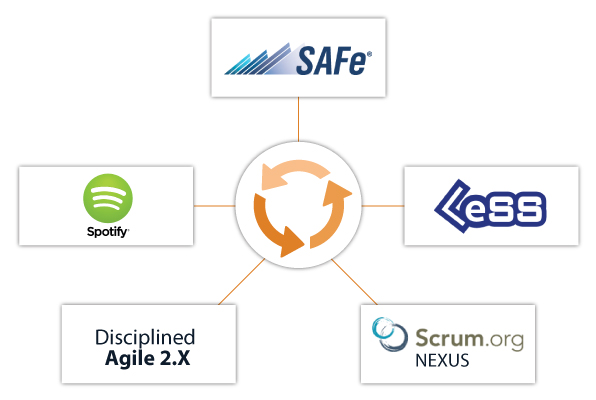With the increasing adoption of agile in larger and more traditional enterprises, the number of methodologies and frameworks to help these companies scale their agile practices is also growing.
There are new players entering the market, while old players are gaining more traction. Some are small, niche methodologies but some, like Nexus from Scrum.org, have the potential to be widely adopted in the coming years.
Gartner recently released a ‘Market Guide for Enterprise Agile Frameworks’ which summarised no less than 13 different frameworks. In the 10th Annual State of Agile Report by VersionOne, a further four methodologies for scaling Agile were represented.
Agile Frameworks – Established
The bigger players in this field that you may already be familiar with are:

SAFe and LeSS, and to a lesser extent Disciplined Agile 2.0, have well established case histories, comprehensive training and widespread consulting support. The Spotify model has somewhat more anecdotal case studies but has a relatively widespread knowledge.
Nexus is quite new to the market, being released in mid-2015 but as it comes from Scrum.org and being relatively light-weight, we expect that it will have an impact in the coming months and years.
Agile Frameworks – Contenders
Lesser known contenders include:

The purpose of mentioning all of these frameworks is not to further muddy the already murky waters as to “what is the right way to scale” but just to highlight the growth, maturity and the diversity in this area. As more startups evolve to larger companies, and more enterprises undertake the journey of “going agile”, and as practitioners we collectively gain more experience in scaling agile – we are learning that there is no one “right” way and a broader set of defined options is a valuable thing.
Are agile frameworks in competition or complementary?
These frameworks may not necessarily be in competition and it may not be a choice of one over the others – there may be complementary combinations. Indeed, several of the frameworks are more like a collection of practices that could be applied within the structure of a more formalised framework. Others, such as ScALeD, are a list of principals that compliment the agile manifesto. The Spotify model, is not an enterprise framework but more of an approach for setting up high-performing teams and groups.
Recommendation: Choose an Agile framework and commit
If you are in the position where you need to choose a framework to assist your organisation with your Agile Transformation, with at least 17 different frameworks in the marketplace, how do you choose one or a combination that is the best fit to get you on your way?
It is definitely not a decision to be taken lightly. You must have a clear view of where the organisation is now, and where they would like to be after successfully applying agile at scale. This means examining your current culture, agile maturity, your appetite and ability to manage organisational change, the drivers for change, the technical environment and how it can best support agile delivery.
Recommendation: Consider your context
Also the choice of framework may be influenced by what support is available, such as skilled practitioners, training or consulting support. Regardless of the framework selected, it should be implemented with a view of constant inspection and relentless adaption for your particular environment and needs. A clear, long term view of success, the right support and the commitment to stay the course are essential regardless of your chosen methodology.
Suggested Reading:
Market Guide for Enterprise Agile Frameworks, 16 June 2016, G00301616 by analyst(s): Mike West, Nathan Wilson and Stefan Van Der Zijden


